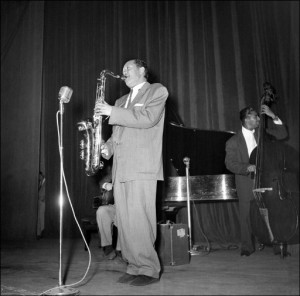Diaa Bekheet | Washington, DC – Lester Young was one of the most influential saxophonists of the swing era, introducing a unique approach to improvisation that provided much of the basis for modern jazz solo conception. He was known for his famous smooth tone and relaxed lyrical style. Many saxophonists have copied his style, and many others – including Dexter Gordon – were primarily influenced by him.
Young was born in Mississippi in 1909. He played saxophone, violin, trumpet, and drums. He spent a great deal of his boyhood touring with his family’s band in both the vaudeville and carnival circuits. When he was 18 years old, he left the band, refusing to tour with it in the Southern United States, where Jim Crow laws were in effect and racial segregation was required in public facilities. In 1927, Young started touring with regional dance bands, including Walter Page’s Blue Devils that formed the core of what became the Count Basie Orchestra. His style and sophisticated harmonies with Count Basie’s Orchestra gained him popularity and prominence.
He played with other jazz legends, including Nat King Cole, Buddy Rich, Oscar Peterson, Dizzy Gillespie, Miles Davis, Charlie Parker and Billie Holiday who gave him the nickname, Prez.
I profiled Young in the early 1990s as part of my Jazz Club USA series on legendary Americans. I also talked about Benny Goodman and Oscar Peterson.
[audio: http://www.voanews.com/MediaAssets2/english/2012_03/Lester_Young.mp3]Young, who held his saxophone out to the side when others held it upright, had an exceptional personality. Some considered him eccentric, but his eccentricity earned him recognition as the original hipster. His signature clothing style, including a “porkpie hat”, was part of his legend. This particular hat style inspired jazz bassist and bandleader Charles Mingus to write his elegiac tune “Goodbye Porkpie Hat”. The composition was later renamed “Theme for Lester Young” after Young died in New York on March 15, 1959. He was 49.
Young was one of icons included in A Great Day in Harlem, a rare Oscar-nominated documentary film on the history of jazz. For me, the title, A Great Day in Harlem, always brings a flashback of a 1958 historic photo showing dozens of legendary Jazz musicians who gathered around a brownstone between Madison and Fifth avenues in New York City for a group picture by Esquire magazine photographer Art Kane. He rightly calls it “the greatest picture of that era of musicians ever taken.” The magazine published the photo in its January 1959 issue.
http://www.youtube.com/watch?v=Jf-cTg9a3_c#t=56m43s
For more on jazz music, listen to VOA’s Jazz America


One response to “Lester Young’s Smooth Tone”
Hello! I merely want to make a enormous thumbs up with the great info you’ve here during this post. We are returning to your blog for additional soon.